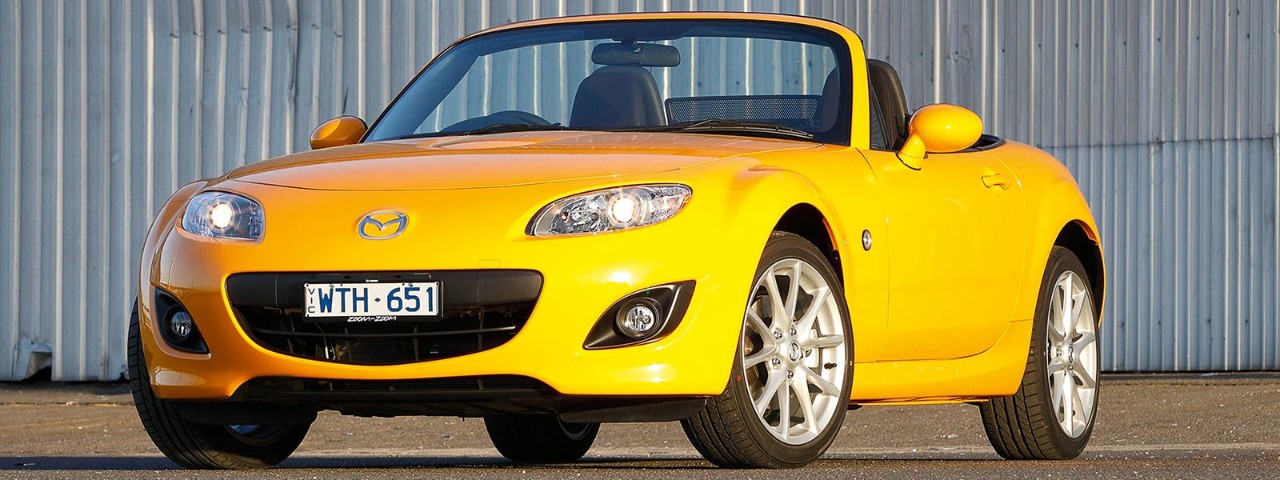The ninth-generation Toyota HiLux has arrived, bringing with it a futuristic forward exterior design, more safety and tech and the same rugged capability owners love. Will the updates tempt private buyers away from the Ford Ranger or are they just enough to keep fleets onside?
Mazda MX-5 used car review

RACV rates the second-hand MX-5, Mazda’s classic roadster.
Mazda’s MX-5 is a modern classic. The driving experience lives up to the promise presented by the compact, two-door roadster body. It is fun and user-friendly and, unlike many sports cars which need to be driven at 10-tenths to be appreciated, the rear-wheel-drive MX-5’s dynamics are sharp but civilised.
Released in 1989, MX-5 has evolved but nevertheless stayed true to its original character and style. By the third-generation NC soft-top, released in late 2005, it was bolder-looking, a little bigger, better equipped, stronger and safer.
In this article
Driver enjoyment
Owning an MX-5 is more about driver involvement and enjoyment than speed. It is superbly balanced with precise handling, sharp steering and great road-holding. Stepping up to a 2.0-litre engine in the NC saw better performance and fuel consumption. The slick-shifting six-speed manuals have been popular, however the auto, which went from a four-speed to a six-speed with shift paddles, has more sporting character than its predecessors. To match the improved performance, the NC has bigger brakes, stability control, more linear steering and a multi-link rear suspension.
MX-5 is strictly a snug two-seater with a small boot. Mechanical/operating noise is higher than in a sedan but that’s part of the sports car experience.
A more-expensive hard-top convertible, with a hard plastic roof that sits behind the seats so it doesn’t rob boot space, joined the range in late 2006.
The NC Series II in March 2009 was more than a facelift. Power and torque was the same but substantial engine changes provided a smoother, more responsive performance delivery and better fuel economy. Seat comfort was improved and tweaks to the steering and suspension sharpened the handling.
Styling changes
In late 2013, the NC Series III brought minor styling and trim changes along with revised accelerator and brake characteristics. The NC, which had a variety of spec levels and special editions, was replaced in 2015 by the ND series. When comparing NCs on the used market, be aware that there were a number of spec levels and special editions.
MX-5 displays Mazda’s usual solid construction, high build quality and reliability. Leaking roofs are not common but as with any soft-top check the carpet for signs of dampness or water damage.
Most of the problems RACV vehicle inspectors find on MX-5 are normal wear items. Check the clutch, gearshift and transmission operation. Look for uneven tyre wear and make sure everything functions properly, such as power windows and the radio. And NC models do not have a spare wheel, only a repair kit.
Service history is valuable
An up-to-date-service history is valuable. Cars that are only used on the weekend still must be serviced at least once a year – this is vital.
But some enthusiasts will have used their MX-5s competitively. Bolt holes in the parcel shelf, where a roll-bar was fitted, and performance add-ons such as a larger exhaust can indicate it’s been driven hard or raced.
|
Fuel consumption |
For a sports car, MX-5 is relatively economical. Expect 8.0-10.0L/100km in normal driving conditions. |
|---|---|
|
Safety |
Side airbags were introduced with the NC series and it has a four-star ANCAP rating. |
|
Towing |
Not recommended. |
|
The competition |
MINI Cooper cabrio, Toyota 86, Subaru BRZ, Nissan 350Z. |
|
Price range |
Convertible (2006-12): $15,300-$27,400 Approximate Glass’s Guide prices. |


